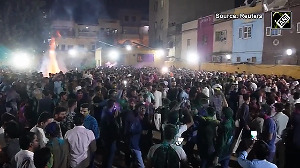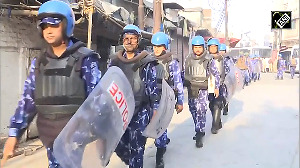Three terrorists struck again in Karachi in Pakistan on February 22, when they opened fire on some Shias watching a World Cup match outside an Imambargah, a Shia place of worship. Nine people were killed, eight of them Shias, all Kashmiris belonging to Gilgit in the Northern Areas. Subsequently, there were violent disturbances in Gilgit when the bodies of five of them were taken there for burial. To understand the background to this, one has to go into the history of the Northern Areas and the Sunni-Shia divide.
Of the Kashmiri territory occupied by Pakistan in 1947-1948, the Sunni majority areas (4,144 square miles) were constituted by it into a separate administrative unit which Pakistan calls 'Azad Kashmir' ('Free Kashmir') and India calls Pakistan-occupied Kashmir, PoK. The Shia majority areas of Gilgit and Baltistan (29,814 square miles), which were known before 1947 as the Northern Areas of Jammu and Kashmir and which had been given on lease by the pre-1947 ruler of Jammu and Kashmir to the British, were incorporated into Pakistan and are directly ruled from Islamabad.
Zia-ul Haq's government renamed the area as the Northern Areas of Pakistan, thus dropping the reference to its having been part of Jammu and Kashmir.
It is out of this Shia majority territory that Islamabad transferred 1,868 square miles to China in 1963 under the Sino-Pakistan Border Agreement and it is through the NA, which borders China's Xinjiang province, that the Chinese, in collaboration with Pakistani army engineers, built the Karakoram Highway. While this highway was built ostensibly to promote overland trade and tourism between Pakistan and Xinjiang, its alleged misuse by the Tableeghi Jamaat and the Jamaat-e-Islami of Pakistan to infiltrate jihadi cadres under the garb of tourists into Xinjiang to join the fight of the Uighurs for the conversion of Xinjiang into an independent Islamic state led to the Chinese abandoning plans for the
upgradation of the highway drawn up during Benazir Bhutto's second tenure as prime minister (1993 to 1997).
They also stopped issuing tourist visas to Pakistanis for overland travel to Xinjiang. After coming to power in October 1999, Pervez Musharraf, Pakistan's military dictator, initiated exploratory talks with North Korea on possible North Korean assistance for upgradation of the Pakistani portion of the highway. A team of North Korean army engineers visited the NA in this connection in 2001.
Since the late 1990s, this highway is being used by the Chinese for the overland transport of M-11 and M-9 missiles to Pakistan in order to avoid their transport by sea lest the shipments be detected by US intelligence. Despite this, the Washington Times, quoting US intelligence sources, reported in 2001that US satellites had detected the movement of convoys carrying missiles/missile spare parts along the highway.
During Prime Minister Zhu Rongji's visit to Pakistan in the beginning of 2001, the Musharraf government asked him for permission to move North Korean missiles and related equipment too by the overland route via China and then the Karakoram Highway to avoid their movement by sea, lest the ships be detected and intercepted by the US Navy just as they had intercepted a cargo of missiles going by sea to Yemen last year. Beijing agreed to this. Since last year all missile-related movement from North Korea has been along the Karakoram Highway.
Similarly, Pakistani equipment meant for North Korea's uranium enrichment facility presently under construction was also sent through the highway. It is very unlikely that the Chinese were not aware of this, though during their interactions with the rest of the world on the latter's concerns over North Korea's attempts to acquire a military nuclear capability, the Chinese have been giving the impression as if they were taken by surprise. After India mobilised and moved its troops to the Pakistan border following the terrorist attack on the Indian Parliament on December 13, 2001, China and North Korea organised emergency supplies of missiles and spare parts and other military equipment to the Pakistani military via the Karakoram Highway.
In view of the strategic importance of this highway, the Pakistani military-intelligence establishment maintains a tight control over the NA. After the Iranian Revolution of 1979, the Shias of the NA became politically active and started a movement for the conversion of the NA into a separate Shia State to be called the Karakoram province. A revolt by the Shias of Gilgit was ruthlessly suppressed by the Zia-ul Haq regime in 1988, killing hundreds of Shias. An armed group of tribals from Afghanistan and the North-West Frontier Province, led by Osama bin Laden, was inducted by the Pakistan Army into Gilgit and adjoining areas to suppress the revolt.
Even though the report of the enquiry into the crash of the plane carrying Zia, the then US ambassador to Islamabad and other senior officials in August 1988 has not been allowed to be released by the Pakistani army, it is believed by many in Pakistan that the crash was caused by a Shia airman from Gilgit aggrieved over the bloodbath unleashed on the Shias by bin Laden's tribal hordes at Zia's instance.
To keep the Shias under control, the military-intelligence establishment encouraged the Sunni extremist Sipah-e-Sahaba Pakistan and its militant wing the Lashkar-e-Jhangvi to open their branches in Gilgit. This led to the import of sectarian clashes, which frequently take place in Pakistani Punjab and Karachi, into the NA too. To counter the SSP and the LEJ, the Tehrik-e-Jaffria Pakistan, the Shia organisation, and its militant wing the Sipah Mohammad too opened their branches in NA to help the local Shias.
While the SSP and TEJ came into existence in the 1980s, their militant wings came into existence in the 1990s. The SSP was financially assisted by the intelligence agencies of the USA, Iraq, Saudi Arabia and Pakistan in the 1980s to counter Teheran's activities in the region. Iran retaliated by assisting the TEJ and the Sipah Mohammad.
Being better trained and armed than the TEJ and Sipah Mohammad and enjoying the official patronage of the Pakistani military-intelligence establishment, the SSP and LEJ went on a rampage not only against the Shias of the NA, but also against those living in Punjab and Karachi, killing hundreds of Shias since the late 1980s.
Embarrassed by this, the intelligence agencies of the US and Saudi Arabia cut off contacts with them, but Pakistan's Inter-Services Intelligence and Iraqi intelligence continued to support them -- each for its own reason. The ISI needed them for keeping the Shias of the NA under control. The Iraqis helped them because they not only targeted the Shias of Pakistan, but also Iranians living/working in Pakistan, including some Iranian military officers undergoing training in Pakistan.
After bin Laden formed his International Islamic Front in 1998, the SSP and LEJ joined it. A large number of their cadres went to Afghanistan and helped the Taliban and Al Qaeda, initially in their fight against the Northern Alliance and subsequently in their fight against the US-led coalition after 9/11. After the coalition and Northern Alliance overran the areas controlled by the Taliban and Al Qaeda, the surviving dregs of the SSP, LEJ and other Pakistani constituents of the IIF such as the Harkat-ul-Mujahideen, the HUM-International (Al Almi), the Harkat-ul-Jihad-Al-Islami and the Lashkar-e-Tayyaba retreated into Pakistan along with the dregs of Al Qaeda and jihadi groups from South-East Asia.
While the jihadi elements from South East Asia returned to their respective countries, the dregs from Al Qaeda and the Pakistani components took shelter in the NWFP, the Federally-Administered Tribal Areas, Karachi, PoK and the NA. The SSP and LEJ, along with the other components of the IIF, were involved in a number of terrorist attacks on the Christians in different parts of Pakistan, whom they held to be surrogates of the US, as well as in the kidnapping and murder of Daniel Pearl, the American journalist, the attack on the French submarine construction experts in Karachi and the explosion outside the US consulate in Karachi last year.
Many of those involved in these incidents have since been arrested or killed by the ISI and the police, often acting on tip-offs from US intelligence officers posted in Pakistan. Musharraf had banned the LEJ and the Sipah Mohammad on August 14, 2001, and extended this ban to cover the SSP and the TEJ on January 15, 2002. Despite this, they continue to be as active as before. Moreover, the ban was confined only to Sindh, Punjab, NWFP and Balochistan, but was not made applicable to the FATA, PoK and the NA.
The Shias of Pakistan by and large kept away from the street protests against the US bombing of Afghanistan because they had not forgiven the massacre of the Shias of Afghanistan (the Hazaras) by Al Qaeda and the Taliban. They have not joined the recent street demonstrations against the planned US attack on Iraq either. The TEJ and the Sipah Mohammad have maintained a studied silence on Iraq and have refrained from criticising the US on its attitude towards the Saddam Hussein government.
Sunni extremist elements belonging to the LEJ, which was declared by the State Department as a Foreign Terrorist Organisation under a 1996 law last month, have started depicting the Shias of Pakistan too as US surrogates and have been accusing them of helping the US intelligence in their actions against the LEJ and other Pakistani components of the IIF. It has also been alleged that some members of the Shia community of Gilgit, presently living in Karachi, have been actively involved in assisting the US intelligence in the hunt for Sheikh Rashid Mohammad, a Pakistani supposedly of Iraqi origin, who is considered to be the master-mind of 9/11.
Two members of the LEJ were recently arrested by the Karachi police. The attack on the Kashmiri Shias from Gilgit in Karachi on February 22 is probably in retaliation for what the LEJ views as their collaboration with US intelligence and their support to the Shia leaders of southern Iraq who have been collaborating with the US.
B Raman retired as additional secretary, Cabinet Secretariat, New Delhi. He is currently, Director, Institute For Topical Studies, Chennai, and Convener, Advisory Committee, Observer Research Foundation, Chennai Chapter.






 © 2025
© 2025